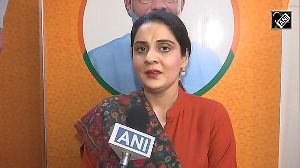A V Poulose
Former Financial Commissioner, Railways
"Around 70% of the increase is due to the buoyancy of the economy and 30% to the innovative measures adopted."
The Indian Railways (IR) surprised everyone by earning a surplus of Rs 14,700 crore (Rs 147 billion) in 2005-06, taking it beyond Rs 20,000 crore (Rs 200 billion) the next year, promising to take it to Rs 21,578 crore (Rs 215.78 billion) in 2007-08, and pushing fund balances to a high of Rs 16,170 crore (Rs 161.70 billion).
As the euphoria seems to be cooling off, it's important to see how this turnaround was achieved. Broadly, permitted overloading following increase in axle loading, and the overall growth of the economy, both yielding increased traffic, aided by rationalisation of freight rates through classification changes, brought about the turnaround. Innovative measures adopted by IR too triggered it.
While overloading was permitted in the 1980s, it was discarded subsequently. Two illustrious civil engineers, who retired as Chairmen, Railway Board, point out (i) "the implications of increasing the axle load and relaxing the examination norms for improving wagon turnaround need to be studied scientifically rather than just empirically" (V K Aggarwal) and (ii) that the overloading is "fraught with the risk of premature failures of both track and wagon components, which could lead to catastrophic accidents to running trains" (M N Prasad).
Studies appear to have been made through the Research Designs and Standards Organisation (RDSO), and strengthening of springs of wagons, track and so on had been undertaken, before extending what was introduced as a trial measure of permitting increased loading for charging. IR should make known widely the precautions already taken before permitting overloading.
The Working Groups reporting on the 11th Five Year Plan had made strong pleas for the rationalisation of railway freight rates to avoid traffic shifting to road transport. Despite this, as pointed out by the CAG, the railways revised upwards the classification of commodities such as coal, iron ore, food grains etc and this raised freight rates.
In the case of passenger earnings, the CAG said, "Various components of passenger fares other than the basic fare such as reservation charges, cancellation charges, clerkage charges etc, were revised. Besides this, the railways introduced a fixed quota in all trains under tatkal reservation scheme for which an additional amount of Rs 50 to Rs 300 per passenger was charged." All these, in spite of the loud declarations about not increasing fares and freight rates across the board!
The aberrations, some of which were introduced surreptitiously, have eroded customer confidence. As a confidence-building measure also, it is time to set up a Tariff Enquiry Committee.
The effect of the changes and innovations has been reflected in the performance of the last two years, and a plateau has already been reached. IR's future will depend heavily on the success of PPP schemes for the much-needed Dedicated Freight Corridor and High-Speed Passenger Corridor projects.
R Sivadasan
Former Financial Commissioner, Railways
"Depreciation funds were used to shore up finances earlier - now, the fund is being added to and profits are still being made"
Any commercial entity is entitled to an optimum utilisation of its assets. I have full confidence that our engineers are fully competent in track maintenance and perfectly capable of optimum utilisation of the available payload of freight stock. The railways are now providing higher sums for upkeep, replacement and maintenance of assets and new improved rolling stock will only further improve productivity. During the last two years, the railways have improved their revenues through a number of measures taken to ensure tremendous improvement in asset utilisation and build-up of additional carrying capacity as announced in the last two years' budgets.
The railways have seen years when their finances were such that dividend payment to the general exchequer was deferred, and funds for financing expenditure on replacement and renewal and pension were used up. Despite this, the railways always reported an "excess" (in revenues) at the end of the year and an Operating Ratio of less than 100 per cent. In 1998-99, the excess reported was Rs 399 crore (Rs 3.99 billion). But the drawdown in the Depreciation Reserve Fund (DRF) was Rs 757 crore (Rs 7.57 billion) and Rs 659 crore (Rs 6.59 billion) in the Pension Fund.
The total drawdown of all funds together was Rs 2,312 crore (Rs 23.12 billion). The Operating Ratio of 93.3 per cent would have been very different if the appropriation to DRF and Pension Fund had been maintained at par with the withdrawal from the funds. In 1999-2000, the total drawdown on railway funds was Rs 1,107 crore (Rs 11.07 billion).
The situation continued to deteriorate till, in 2000-01 and 2001-02, the railways had to defer dividend payment to the extent of Rs 1,823 crore (Rs 18.23 billion) and Rs 1,000 crore (Rs 10 billion) respectively.
The Railway Reforms Committee 1992, had computed the asset replacement needs of the railways as 2.6 per cent of the current replacement cost of all replaceable assets - this works out to around Rs 4,000-5,000 crore (Rs 40-50 billion) per year.
During the last two years, the railways have taken care to step up the contribution to DRF mainly with a view to plug this tendency to manipulate the contributions to various funds. Also, it has certainly not been due to any accounting jugglery that the railways have laid claims of surpassing Rs 20,000 crore (Rs 200 billion) as cash surplus.
All that the railways have done in the 2007-08 budget is to add an additional statement reflecting their cash surplus before dividend in the Earnings Before Interest, Taxes, Depreciation and Amortization (EBITDA) format.
This is one of the most commonly used measures of fundamental operating performance for business enterprises. EBITDA identifies the sustainable, and hopefully growing, stream of cash that will flow from the operating/trading activities of the business and it is a number that is largely free from the distortions that can arise from accounting policies. Operating managers and analysts the world over like it for this reason.






 © 2025
© 2025